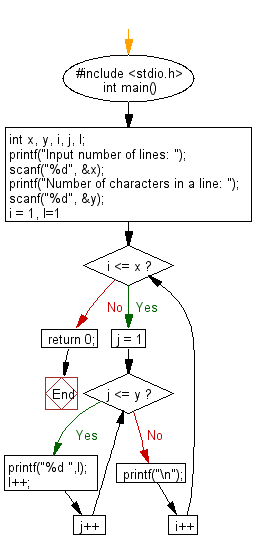C Exercises: Reads two integers p and q, print p number of lines in a sequence of 1 to q in a line
C Basic Declarations and Expressions: Exercise-43 with Solution
Write a C program that reads two integers p and q, print p number of lines in a sequence of 1 to q in a line.
Sample Solution:
C Code:
#include <stdio.h>
int main() {
int x, y, i, j, l;
printf("Input number of lines: ");
scanf("%d", &x);
printf("Number of numbers in a line: ");
scanf("%d", &y);
for(i = 1, l=1; i <= x; i++)
{
for(j = 1; j <= y; j++)
{
printf("%d ",l);
l++;
}
printf("\n");
}
return 0;
}
Sample Output:
Input number of lines: 5 Number of numbers in a line: 6 1 2 3 4 5 6 7 8 9 10 11 12 13 14 15 16 17 18 19 20 21 22 23 24 25 26 27 28 29 30
Flowchart:

C programming Code Editor:
Contribute your code and comments through Disqus.
Previous: Write a C program to print a number, it’s square and cube in a line, starting from 1 and print n lines. Accept number of lines (n, integer) from the user.
Next: Write a C program to calculate the average marks of mathematics of some students. Input 0 (excluding to calculate the average) or negative value to terminate the input process.
What is the difficulty level of this exercise?
Test your Programming skills with w3resource's quiz.
C Programming: Tips of the Day
Static variable inside of a function in C
The scope of variable is where the variable name can be seen. Here, x is visible only inside function foo().
The lifetime of a variable is the period over which it exists. If x were defined without the keyword static, the lifetime would be from the entry into foo() to the return from foo(); so it would be re-initialized to 5 on every call.
The keyword static acts to extend the lifetime of a variable to the lifetime of the programme; e.g. initialization occurs once and once only and then the variable retains its value - whatever it has come to be - over all future calls to foo().
Ref : https://bit.ly/3fOq7XP
- New Content published on w3resource:
- HTML-CSS Practical: Exercises, Practice, Solution
- Java Regular Expression: Exercises, Practice, Solution
- Scala Programming Exercises, Practice, Solution
- Python Itertools exercises
- Python Numpy exercises
- Python GeoPy Package exercises
- Python Pandas exercises
- Python nltk exercises
- Python BeautifulSoup exercises
- Form Template
- Composer - PHP Package Manager
- PHPUnit - PHP Testing
- Laravel - PHP Framework
- Angular - JavaScript Framework
- Vue - JavaScript Framework
- Jest - JavaScript Testing Framework
